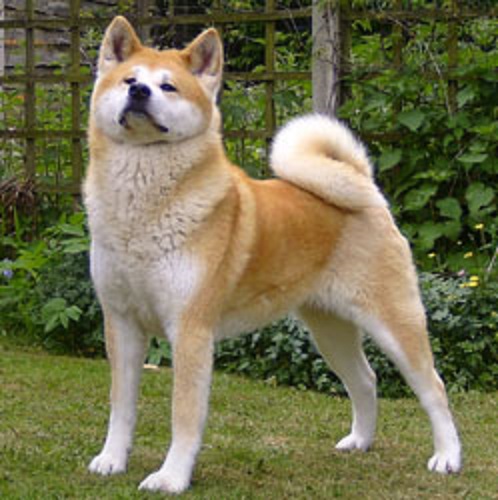
Akita

Navigate through the tabs
Navigate through the tabs below to view the breed's info of your interest.
The breed's info is divided in four sections; namely:
the breed's history ,
the breed's main stats ,
the dog's potential health issues
and finally, how the breed scored in 26 different categories.
All the above information should give you a respectively good overview for the dog of your interest.
Dog Breed's Main Info
The Breed's History:
Japanese history, both verbal and written, describe the ancestors of the Akita, the Matagi dog (hunting dog, Bear hunting dog, Deer hunting dog), as one of the oldest of the native dogs.
Today's Akita developed primarily from dogs in the northernmost region of the island of Honshu in the Akita prefecture, thus providing the breed's name.
The Matagi's quarry included wild boar, Sika deer, and Asian black bear. This precursor dog tracked large game, holding it at bay until hunters arrived to make the kill.
The breed is also influenced by crosses with larger breeds from Asia and Europe, including English Mastiffs, Great Danes, St. Bernards, and the Tosa Inu, in the desire to develop a fighting dog for the burgeoning dog fighting industry in Odate in the early 20th century.
During World War II the Akita was also crossed with German Shepherd Dogs in an attempt to save them from the wartime government order for all non-military dogs to be culled. The ancestors of the American Akita were originally a variety of the Japanese Akita, a form that was not desired in Japan due to the markings, and which is not eligible for show competition.
The story of Hachiko, the most revered Akita of all time, helped push the Akita into the international dog world.
Hachiko was born in 1923 and owned by Professor Hidesaburo Ueno of Tokyo. Professor Ueno lived near the Shibuya Train Station in a suburb of the city and commuted to work every day on the train. Hachiko accompanied his master to and from the station each day.
On May 25, 1925, when the dog was 18 months old, he waited for his master's arrival on the four o'clock train, but Professor Ueno had suffered a fatal brain haemorrhage at work. Hachiko continued to wait for his master's return. He travelled to and from the station each day for the next nine years.
He allowed the professor's relatives to care for him, but he never gave up the vigil at the station for his master. His vigil became world-renowned when, in 1934, shortly before his death, a bronze statue was erected at the Shibuya train station in his honor.
This statue was melted down for munitions during the war and new one was commissioned once the war ended. Each year on April 8 since 1936, Hachiko's devotion has been honoured with a solemn ceremony of remembrance at Tokyo's Shibuya railroad station. Eventually, Hachiko's legendary faithfulness became a national symbol of loyalty, particularly to the person and institution of the Emperor.
In 1931, the Akita was officially declared a Japanese Natural Monument.
Country of Origin:
Japan
Breed Group:
Working
Height:
2 feet to 2 feet 4 inch. feet (61 to 71,12 cm)
Weight:
70 to 130 pounds (31 to 59 Kg)
Life Span:
10 to 12 years
Potential Health Issues:
Hip Dysplasia,
Gastric dilatation-volvulus,
Hypothyroidism,
Progressive Retinal Atrophy (PRA),
Sebaceous adenitis (SA)
Adaptability
Apartment Living:
First Time Owners:
Sensitivity:
Being Alone:
Cold Weather:
Hot Weather:
Friendliness
Affection With Family:
With Kids:
With Dogs:
With Strangers:
Health and Grooming
Shedding:
Drooling:
Easy To Groom:
Overall Health:
Weight Gain Potential:
Size:
Training
Easiness:
Intelligence:
Mouthiness:
Prey Drive:
Barking or Howling:
Wanderlust:
Need For Exercise
Energy Level:
Intensity:
Exercise Needs:
Playfulness:
Our Mobile Application
Check out Our Mobile Application "Dog Breeds Central"
